Monthly Archives: April 2017
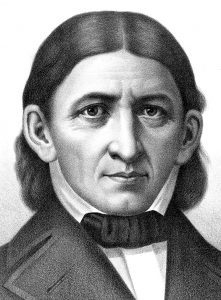 Many people think of Kindergarten as almost a play date. They think of a classroom filled with toys, books, and craft supplies, as well as a playground for recess. Many people think of it as a daycare for working parents, and of course, a place for early childhood development. All these are good things, but this was not the original plan for the creator of Kindergarten, German born Friedrich Wilhelm August Fröbel. He wanted it to be a place that was both ‘a garden for children’, where children meet with environment and also ‘a garden of children’, where they play together and express themselves in a smaller garden world by means of play with their age group. He believed that “children are like tiny flowers; they are varied and need care, but each is beautiful alone and glorious when seen in the community of peers.”
Many people think of Kindergarten as almost a play date. They think of a classroom filled with toys, books, and craft supplies, as well as a playground for recess. Many people think of it as a daycare for working parents, and of course, a place for early childhood development. All these are good things, but this was not the original plan for the creator of Kindergarten, German born Friedrich Wilhelm August Fröbel. He wanted it to be a place that was both ‘a garden for children’, where children meet with environment and also ‘a garden of children’, where they play together and express themselves in a smaller garden world by means of play with their age group. He believed that “children are like tiny flowers; they are varied and need care, but each is beautiful alone and glorious when seen in the community of peers.”
I’m sure this sounds odd to most of us, but when you look at his background, I think you will understand why he felt the way he did. Fröbel had an unhappy childhood with a severe step-mother. He was abandoned and treated in a strict fashion as a child. He got to know what happiness was, when he was living with his uncle’s family while studying at high school. He had a huge desire for education, strong Christian faith and love of nature. He studied mineralogy in Jena,  Germany and architecture at the Berlin’s Humboldt University. Inborn skills of an educator helped Fröbel to realize the failure of teaching system because of its incompleteness and the failure to include the outside world in the educational process. The first kindergarten was established by Fröbel in Bad Blankenburg in 1837. He renamed his Play and Activity Institute to a ‘kindergarten’ two years later in 1840. That Bad Blankenburg Infant school used play, games, songs, stories, and crafts to encourage children’s imagination and broaden their physical and motor skills. “Kommt, lasst uns unsern Kindern leben” Come, let us live with our children’ turned into the catchphrase of the early childhood education.
Germany and architecture at the Berlin’s Humboldt University. Inborn skills of an educator helped Fröbel to realize the failure of teaching system because of its incompleteness and the failure to include the outside world in the educational process. The first kindergarten was established by Fröbel in Bad Blankenburg in 1837. He renamed his Play and Activity Institute to a ‘kindergarten’ two years later in 1840. That Bad Blankenburg Infant school used play, games, songs, stories, and crafts to encourage children’s imagination and broaden their physical and motor skills. “Kommt, lasst uns unsern Kindern leben” Come, let us live with our children’ turned into the catchphrase of the early childhood education.
Friedrich Fröbel also used studying and nurturing plants in a garden for stimulating children’s interest in the natural world. In reality, we can trace the similarities to the Montessori school system and the Pestalozzian consideration of importance to grow up in harmony with nature. Fröbel paid much attention to preparing for 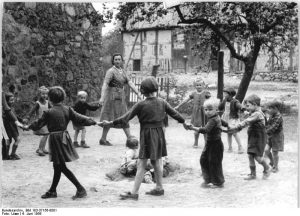 further school education by training the children through the complimentary self expression, creativeness, collective involvement, and motor activity. He considered training of all the vivid faculties: artistic, imaginative, linguistic, arithmetical, musical, aesthetic, scientific, physical, social, moral, cultural, and spiritual, complete growth and harmonious development to be even more important than any kind of knowledge. Fröbel’s kindergarten system flourished globally. Most kindergartens were organized for children of all social classes, ethnic groups and religious believes, Jewish as well as Christian. Fröbel’s vision of kindergarten seems to be so familiar and proper, however it was a fresh and revolutionary look on early childhood education in his time.
further school education by training the children through the complimentary self expression, creativeness, collective involvement, and motor activity. He considered training of all the vivid faculties: artistic, imaginative, linguistic, arithmetical, musical, aesthetic, scientific, physical, social, moral, cultural, and spiritual, complete growth and harmonious development to be even more important than any kind of knowledge. Fröbel’s kindergarten system flourished globally. Most kindergartens were organized for children of all social classes, ethnic groups and religious believes, Jewish as well as Christian. Fröbel’s vision of kindergarten seems to be so familiar and proper, however it was a fresh and revolutionary look on early childhood education in his time.
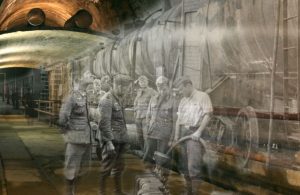
 So much is still unknown about the things that Adolf Hitler did, including an apparent “Ghost Train” that was filled with gold and other treasures. According to legend, as the Soviet forces approached in the final days of World War II, an armored train left the city of Breslau (now Wroclaw, Poland) in April 1945 and headed west toward Waldenburg (now Walbrzych). Somewhere along the 40 mile trip, the train and its cargo of gold and other treasures…many of them stolen by the Nazis from Jewish families…vanished into the Owl Mountains, never to be seen again, except in local legend. Stories of the Nazi “Ghost Train” date back some 70 years, although historians haven’t been able to conclusively prove the train ever existed. During the war, Hitler ordered the creation of a network of underground tunnels in the Owl Mountains, which at the time were under German control, as part of a project known as “Riese,” meaning “Giant.” The original rumor of a Nazi train hidden in the mountains came from a Polish miner, who claimed that just after the war, German miners told him they had seen the train being pushed into one of the tunnels.
So much is still unknown about the things that Adolf Hitler did, including an apparent “Ghost Train” that was filled with gold and other treasures. According to legend, as the Soviet forces approached in the final days of World War II, an armored train left the city of Breslau (now Wroclaw, Poland) in April 1945 and headed west toward Waldenburg (now Walbrzych). Somewhere along the 40 mile trip, the train and its cargo of gold and other treasures…many of them stolen by the Nazis from Jewish families…vanished into the Owl Mountains, never to be seen again, except in local legend. Stories of the Nazi “Ghost Train” date back some 70 years, although historians haven’t been able to conclusively prove the train ever existed. During the war, Hitler ordered the creation of a network of underground tunnels in the Owl Mountains, which at the time were under German control, as part of a project known as “Riese,” meaning “Giant.” The original rumor of a Nazi train hidden in the mountains came from a Polish miner, who claimed that just after the war, German miners told him they had seen the train being pushed into one of the tunnels.
In 2015, two anonymous men contacted officials in Walbrzych, a district in southwestern Poland, claiming to know the train’s location and demanding 10 percent of the value of its contents in exchange for leading authorities there. According to Marika Tokarska, an official in the southwestern Polish district of Walbrzych, a law firm representing two men…a Pole and a German, who prefer to remain anonymous…sent her office two letters, offering a description of the train and its contents and claiming to know its location. The documents received from the law firm claim the train is some 490 feet long and loaded with guns, precious metals and other valuables, including up to 300 tons of gold. In exchange for revealing the train’s location, the men are demanding 10 percent of the value of its contents. Although there is much skepticism expressed by historians as to the validity of the men’s claims, authorities in Walbrzych say they will pay the reward if the information turns out to be legitimate. I guess I would too. The men are asking 10% of the total, which could be a huge amount, but not nearly as much as the remaining 90%, so paying them would make sense. As Tokarska told the Associated Press: “We believe that a train has been found. We are taking this information seriously.” Though the men’s knowledge of the train’s contents and their retaining of a lawyer lend legitimacy to their claims, there is still plenty room for skepticism: The first letter from the men’s law firm included several references to local topography suggesting the men might not be as familiar with the area as they claim, and previous searches for the train in recent years have yielded nothing.
Andreas Richter, a German, and Piotr Koper, a Pole, moved in with heavy equipment and dug deep at a site near rail tracks in Walbrzych, following comments by residents who said they had knowledge of the train’s 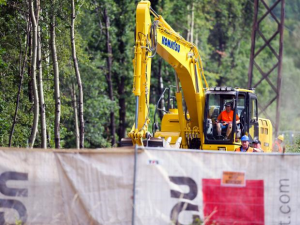
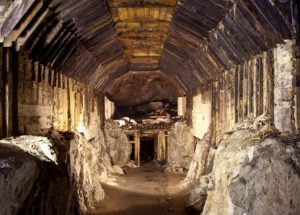 existence. Richter and Koper said that their own tests using earth-penetrating radar confirmed a train was at the site. Nevertheless, after an initial dig, the crew turned up no sign of the “Ghost Train.” Still, they have not given up just yet. There are plans in place to dig again in the very near future. The two men are determined to prove that they have found the real “Ghost Train,” and to claim the 10% share they were promised, it they find it.
existence. Richter and Koper said that their own tests using earth-penetrating radar confirmed a train was at the site. Nevertheless, after an initial dig, the crew turned up no sign of the “Ghost Train.” Still, they have not given up just yet. There are plans in place to dig again in the very near future. The two men are determined to prove that they have found the real “Ghost Train,” and to claim the 10% share they were promised, it they find it.
 We all know about the International Space Station these days, but any previous space stations were not really very well known…at least I didn’t know much about them. The United States and Russia have been in competition for years, and over far more than the space program, but it was one area that they carried on a heated competition over. It seems like one or the other was always a little bit ahead, but there were a few places that Russia definitely beat the United States. One such area was the Space Station.
We all know about the International Space Station these days, but any previous space stations were not really very well known…at least I didn’t know much about them. The United States and Russia have been in competition for years, and over far more than the space program, but it was one area that they carried on a heated competition over. It seems like one or the other was always a little bit ahead, but there were a few places that Russia definitely beat the United States. One such area was the Space Station.
On April 19, 1971, the Soviet Union (Russia) launched Salyut 1 (English translation: Salute 1). It was the first space station of any kind. More stations followed in the Salyut program, and there are parts of that space station program that are still in use on the International Space Station today. Salyut 1 originated as a modification of the military Almaz space station program that the Soviets were developing at that time. After the landing of Apollo 11 on the Moon in July 1969, the Soviets began shifting the primary emphasis of their manned space program to orbiting space stations, with a possible lunar landing later in the 1970s if the N-1 booster became flight-worthy (which it didn’t). I suppose that since the moon landing had already happened, they decided to  focus their efforts on something they could be first at. It was the perfect motivation for the space station program…a desire to one-up the United States Skylab program, which was already in development. The basic structure of Salyut 1 was adapted from the Almaz with a few modifications and would form the basis of all Soviet space stations through Mir.
focus their efforts on something they could be first at. It was the perfect motivation for the space station program…a desire to one-up the United States Skylab program, which was already in development. The basic structure of Salyut 1 was adapted from the Almaz with a few modifications and would form the basis of all Soviet space stations through Mir.
Several military experiments were nonetheless carried on Salyut 1, including the OD-4 optical visual ranger, the Orion ultraviolet instrument for characterizing rocket exhaust plumes, and the highly classified Svinets radiometer. Construction of Salyut 1 began in early 1970 and after nearly a year, it was shipped to the Baikonur Cosmodrome. Some remaining assembly work had yet to be done and this was completed at the launch center. Launch was planned for April 12, 1971 to coincide with the 10th anniversary of Yuri Gagarin’s flight on Vostok 1, but technical problems delayed it until the 19th. The first crew launched later in the Soyuz 10 mission, but they ran into troubles while docking and were unable to enter the station; the Soyuz 10 mission was aborted and the crew returned safely to Earth. Its second crew launched in Soyuz 11 and remained on  board for 23 days. This was the first time in the history of spaceflight that a space station had been manned, and a new record in time spent in space. This success was, however, overshadowed when the crew was killed during re-entry, as a pressure-equalization valve in the Soyuz 11 re-entry capsule had opened prematurely, causing the crew to asphyxiate. After this accident, missions were suspended while the Soyuz spacecraft was redesigned. The station was intentionally destroyed by de-orbiting it after six months in orbit, because it ran out of fuel before a redesigned Soyuz spacecraft could be launched to it. Space stations have come a long way since that first station, but the Salyut 1 will always have the place of honor as the very first one.
board for 23 days. This was the first time in the history of spaceflight that a space station had been manned, and a new record in time spent in space. This success was, however, overshadowed when the crew was killed during re-entry, as a pressure-equalization valve in the Soyuz 11 re-entry capsule had opened prematurely, causing the crew to asphyxiate. After this accident, missions were suspended while the Soyuz spacecraft was redesigned. The station was intentionally destroyed by de-orbiting it after six months in orbit, because it ran out of fuel before a redesigned Soyuz spacecraft could be launched to it. Space stations have come a long way since that first station, but the Salyut 1 will always have the place of honor as the very first one.
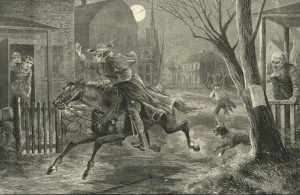 When the United States was first trying to become a sovereign nation, due to the unfair treatment it received from its parent nation, Great Britain, King George III’s army tried to stop it in any way they could. I’m sure the king could see the possibilities this nation had, and I’m also sure he could see the writing on the wall concerning our independence. Still, the king said to fight, so fight they did. The people in the colonies thought the king’s rule was tyrannical and infringed on the colonists’ “rights as Englishmen”, and so they declared the colonies were going to be free and independent states. A war ensued, that we know as the Revolutionary War.
When the United States was first trying to become a sovereign nation, due to the unfair treatment it received from its parent nation, Great Britain, King George III’s army tried to stop it in any way they could. I’m sure the king could see the possibilities this nation had, and I’m also sure he could see the writing on the wall concerning our independence. Still, the king said to fight, so fight they did. The people in the colonies thought the king’s rule was tyrannical and infringed on the colonists’ “rights as Englishmen”, and so they declared the colonies were going to be free and independent states. A war ensued, that we know as the Revolutionary War.
On April 7, 1775, British activity suggested the possibility of troop movements, and Dr Joseph Warren, an American physician who played a leading role in American Patriot organizations in Boston in the early days of the American Revolution, sent Paul Revere to warn the Massachusetts Provincial Congress, which was located in Concorde. This was also the site of one of the larger caches of Patriot military supplies. The warning spurred the residents into action…moving the military supplies away from the town. Just one week later, on April 14, General Gage received instructions from Secretary of State William Legge, Earl of Dartmouth. The orders had been dispatched on January 27. The British soldiers were told to disarm the rebels. It was known that they often hid weapons in Concord, as well as other locations. They were told to imprison the rebellion’s leaders, especially Samuel Adams and John Hancock. Dartmouth gave Gage considerable discretion in his commands. Gage issued orders to Lieutenant Colonel Francis Smith to proceed from Boston “with utmost expedition and secrecy to Concord, where you will seize and destroy… all Military stores…. But you will take care that the soldiers do not plunder the inhabitants or hurt private property.” Gage did not issue written orders for the arrest of rebel leaders, because he was afraid that doing so might spark an uprising.
On the night of April 18, 1775, with tensions rising, Joseph Warren went to see Revere and William Dawes. He told them that the king’s troops were about to embark in boats from Boston bound for Cambridge, as well as the road to Lexington and Concord. Warren’s intelligence suggested that the most likely objectives of the 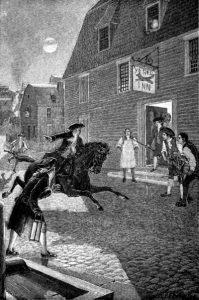 regulars’ movements later that night would be the capture of Adams and Hancock. They did not worry about the possibility of regulars marching to Concord, since the supplies at Concord were safe, but they did think their leaders in Lexington were unaware of the potential danger that night. Revere and Dawes were sent out to warn them and to alert colonial militias in nearby towns. Prior to this time, Revere had instructed Robert Newman, the sexton of the North Church, to send a signal by lantern to alert colonists in Charlestown as to the movements of the troops when the information became known. In what is well known today by the phrase “one if by land, two if by sea”, one lantern in the steeple would signal the army’s choice of the land route while two lanterns would signal the route “by water” across the Charles River. The British would ultimately take the water route, so two lanterns were placed in the steeple. Revere first gave instructions to send the signal to Charlestown. He then crossed the Charles River by rowboat, slipping past the British warship HMS Somerset at anchor. Crossings were banned at that hour, but Revere safely landed in Charlestown and rode to Lexington, avoiding a British patrol and later warning almost every house along the route. The Charlestown colonists dispatched additional riders to the north. Riding through present-day Somerville, Medford, and Arlington, Revere warned patriots along his route, many of whom set out on horseback to deliver warnings of their own. By the end of the night there were probably as many as 40 riders throughout Middlesex County carrying the news of the army’s advance. Revere did not shout the phrase “The British are coming!” The success of his mission depended on secrecy, and the countryside was filled with British army patrols, and most of the Massachusetts colonists, who were predominantly English loyalists. Revere’s warning, according to eyewitness accounts of the ride and Revere’s own descriptions, was “The Regulars are coming out.” Revere arrived in Lexington around midnight, with Dawes arriving about a ½ hour later. They met with Samuel Adams and John Hancock, spending a great deal of time discussing plans of action. They believed that the forces leaving the city were too large for the sole purpose of arresting two men and that Concord was the main target. The Lexington men dispatched riders to the surrounding towns, and Revere and Dawes continued along the road to Concord accompanied by Samuel Prescott, a doctor who happened to be in Lexington. Revere, Dawes, and Prescott were detained by a British Army patrol in Lincoln at a roadblock on the way to Concord. Prescott jumped his horse over a wall and escaped into the woods. He eventually reached Concord. Dawes also escaped, but fell off his horse not long after and did not complete the ride. After being roughly questioned for an hour or two, Revere was released when the patrol heard Minutemen alarm guns being fired on their approach to Lexington.
regulars’ movements later that night would be the capture of Adams and Hancock. They did not worry about the possibility of regulars marching to Concord, since the supplies at Concord were safe, but they did think their leaders in Lexington were unaware of the potential danger that night. Revere and Dawes were sent out to warn them and to alert colonial militias in nearby towns. Prior to this time, Revere had instructed Robert Newman, the sexton of the North Church, to send a signal by lantern to alert colonists in Charlestown as to the movements of the troops when the information became known. In what is well known today by the phrase “one if by land, two if by sea”, one lantern in the steeple would signal the army’s choice of the land route while two lanterns would signal the route “by water” across the Charles River. The British would ultimately take the water route, so two lanterns were placed in the steeple. Revere first gave instructions to send the signal to Charlestown. He then crossed the Charles River by rowboat, slipping past the British warship HMS Somerset at anchor. Crossings were banned at that hour, but Revere safely landed in Charlestown and rode to Lexington, avoiding a British patrol and later warning almost every house along the route. The Charlestown colonists dispatched additional riders to the north. Riding through present-day Somerville, Medford, and Arlington, Revere warned patriots along his route, many of whom set out on horseback to deliver warnings of their own. By the end of the night there were probably as many as 40 riders throughout Middlesex County carrying the news of the army’s advance. Revere did not shout the phrase “The British are coming!” The success of his mission depended on secrecy, and the countryside was filled with British army patrols, and most of the Massachusetts colonists, who were predominantly English loyalists. Revere’s warning, according to eyewitness accounts of the ride and Revere’s own descriptions, was “The Regulars are coming out.” Revere arrived in Lexington around midnight, with Dawes arriving about a ½ hour later. They met with Samuel Adams and John Hancock, spending a great deal of time discussing plans of action. They believed that the forces leaving the city were too large for the sole purpose of arresting two men and that Concord was the main target. The Lexington men dispatched riders to the surrounding towns, and Revere and Dawes continued along the road to Concord accompanied by Samuel Prescott, a doctor who happened to be in Lexington. Revere, Dawes, and Prescott were detained by a British Army patrol in Lincoln at a roadblock on the way to Concord. Prescott jumped his horse over a wall and escaped into the woods. He eventually reached Concord. Dawes also escaped, but fell off his horse not long after and did not complete the ride. After being roughly questioned for an hour or two, Revere was released when the patrol heard Minutemen alarm guns being fired on their approach to Lexington.
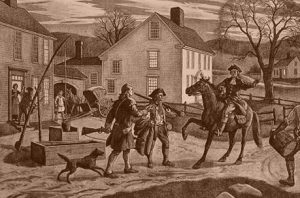
About 5am on April 19, 700 British troops under Major John Pitcairn arrived at the town to find a 77 man strong colonial militia under Captain John Parker waiting for them on Lexington’s common green. Pitcairn ordered the outnumbered Patriots to disperse, and after a moment’s hesitation, the Americans began to drift off the green. Suddenly, the “shot heard around the world” was fired from an undetermined gun, and a cloud of musket smoke soon covered the green. When the brief Battle of Lexington ended, eight Americans lay dead and 10 others were wounded Only one British soldier was injured. The American Revolution had begun.
 Brian Cratty, who is my sister-in-law, Jennifer Parmely’s partner, is just as athletic as she is. They love to hike, ski, snow shoe, and a variety of other activities together. Last September, they hiked the Colorado Trail, which culminated in 14,000 foot peak. Jennifer told me that it was pretty difficult, and since that is quite a bit higher than the highest hike I have made, I can only imagine. From what I understand, Brian did very well with it, however. Maybe the fact that Brian is a pilot has something to do with being able to acclimate to those higher altitudes. Brian is retired now, but he spent a number of years flying for Wyoming Medical Center, where Jennifer is a nurse.
Brian Cratty, who is my sister-in-law, Jennifer Parmely’s partner, is just as athletic as she is. They love to hike, ski, snow shoe, and a variety of other activities together. Last September, they hiked the Colorado Trail, which culminated in 14,000 foot peak. Jennifer told me that it was pretty difficult, and since that is quite a bit higher than the highest hike I have made, I can only imagine. From what I understand, Brian did very well with it, however. Maybe the fact that Brian is a pilot has something to do with being able to acclimate to those higher altitudes. Brian is retired now, but he spent a number of years flying for Wyoming Medical Center, where Jennifer is a nurse.
While Jennifer likes hiking more than bicycling, the same cannot be said of Brian. When we decided to take a group hike, Brian went off ahead on his bicycle. He crisscrossed all over the trail we were on, but oddly we only saw him once while we hiked. Brian and Jennifer love to spend time on the mountain, and a while back, they came into a sweet deal. They had been using a friends cabin, in exchange for keeping an eye on it, and since he hadn’t been back to Wyoming to use it in quite some time, and had the need for some money to pay medical bills, he offered to sell the cabin to Brian and Jennifer. And they  jumped at the chance. Now they spend as much time as they can, at the cabin, fixing it up and just enjoying it. It is going to be really nice when they get it done.
jumped at the chance. Now they spend as much time as they can, at the cabin, fixing it up and just enjoying it. It is going to be really nice when they get it done.
Jennifer has been so happy since she met Brian, and we are all very happy for her. They really make a great team. He is a kindhearted and compassionate person, and that has been a blessing over the past few years, especially when the family lost their dad, Walt Schulenberg. I don’t know if his compassion has to do with his years of flying Life Flight or not, but I tend to think that he is just a very kind person, and he understands the needs of those around him. It is a wonderful trait to have. Today is Brian’s birthday. Happy birthday Brian!! Have a great day!! We love you!!
 The older I get, the more that I know that Heaven is my true home. Never is that fact more clear, than on Resurrection Sunday, because whether we know the exact day or not, we know that it was that day that the Christians first knew that they were truly right with God again. Many people have disputed the celebration of Easter, or Resurrection Sunday, saying that it’s roots were in paganism, but I have to say that I refuse to give the devil any day on this earth. I know why I celebrate Easter. It’s not because of a bunny, but because of a lamb. Jesus is the Lamb of God…the sacrifice that paid for the sins of the world…past, present, and future. And now, because He lives, I know that I can face tomorrow. It is because of the grace of God…the unearned, unmerited favor and mercy of a loving God that I get to spend eternity in Heaven with
The older I get, the more that I know that Heaven is my true home. Never is that fact more clear, than on Resurrection Sunday, because whether we know the exact day or not, we know that it was that day that the Christians first knew that they were truly right with God again. Many people have disputed the celebration of Easter, or Resurrection Sunday, saying that it’s roots were in paganism, but I have to say that I refuse to give the devil any day on this earth. I know why I celebrate Easter. It’s not because of a bunny, but because of a lamb. Jesus is the Lamb of God…the sacrifice that paid for the sins of the world…past, present, and future. And now, because He lives, I know that I can face tomorrow. It is because of the grace of God…the unearned, unmerited favor and mercy of a loving God that I get to spend eternity in Heaven with  Him. That is what the day is about, and if we are celebrating it on the wrong day, I don’t think God will mind. It’s not about getting the day right, but rather getting the reason right.
Him. That is what the day is about, and if we are celebrating it on the wrong day, I don’t think God will mind. It’s not about getting the day right, but rather getting the reason right.
The sacrifice that Jesus made on Good Friday was so much more than what we often think about. Yes, when Jesus died…an innocent man, it was to forgive all our sins, past, present, and future, but the reason he returned to the earth was to justify us…to put us back in right standing with God forever…just as if we had never sinned. That is why we can say that we are a new creation when we accept Jesus as our Lord and Saviour…because God no longer sees our sins. They are gone forever. When Jesus died on the cross, the sacrifice was enough.  Nothing more is required, and all we have to do is accept Jesus as our Lord and Saviour, and we are going to Heaven. The cross was all it took…the cross was enough!!
Nothing more is required, and all we have to do is accept Jesus as our Lord and Saviour, and we are going to Heaven. The cross was all it took…the cross was enough!!
Most of God’s celebratory days, include a feast, and Resurrection Sunday should be no different. Resurrection Day is a celebration, after all. Someone said that Earth’s saddest day, and it happiest day…are only three days apart. Today, I am thankful for the sacrifice my Lord Jesus made, and for the triumphant return to earth that followed so that I could always know that the cross was enough, and I am going to be alright…now and in Heaven. Thank you Jesus, for your sacrifice!! Happy Resurrection Day everyone. Have a blessed day!!
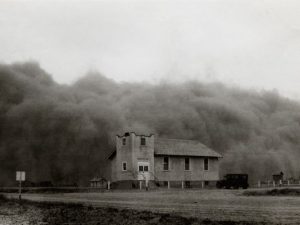
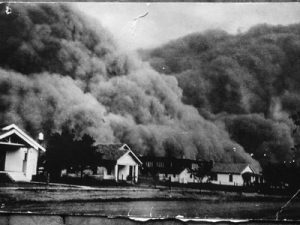 In the late 19th century, America was growing. The pioneers headed west, because many couldn’t resist the lure of the tall grassy land in the midwestern and southern plains of the United States. They planned to settled there to farm. The next few decades were prosperous, but when the 1930s rolled in, so did strong winds, drought, and clouds of dust that plagued nearly 75 percent of the United States between 1931 and 1939. The Dust Bowl, as it was known, had arrived. The problem likely began in the early 1920s, when a post-World War I recession led farmers to try new mechanized farming techniques as a way to increase profits. Many bought plows and other farming equipment, and between 1925 and 1930 more than 5 million acres of previously unfarmed land was plowed. With the help of mechanized farming, farmers produced record crops during the 1931 season. However, overproduction of wheat coupled with the Great Depression led to severely reduced market prices. The wheat market was flooded, and people were too poor to buy. Farmers were unable to earn back their production costs and expanded their fields in an effort to turn a profit. The prairie was covered with wheat in place of the natural drought-resistant grasses, and to add to the problem, they left any unused fields bare. With the drought leaving much of the country severely dry, no natural grasses to hold the dirt in place, the higher than normal temperatures, and increasingly strong winds, the country was hit with what many called Black Blizzards, which were rolling dust storms driven by high winds.
In the late 19th century, America was growing. The pioneers headed west, because many couldn’t resist the lure of the tall grassy land in the midwestern and southern plains of the United States. They planned to settled there to farm. The next few decades were prosperous, but when the 1930s rolled in, so did strong winds, drought, and clouds of dust that plagued nearly 75 percent of the United States between 1931 and 1939. The Dust Bowl, as it was known, had arrived. The problem likely began in the early 1920s, when a post-World War I recession led farmers to try new mechanized farming techniques as a way to increase profits. Many bought plows and other farming equipment, and between 1925 and 1930 more than 5 million acres of previously unfarmed land was plowed. With the help of mechanized farming, farmers produced record crops during the 1931 season. However, overproduction of wheat coupled with the Great Depression led to severely reduced market prices. The wheat market was flooded, and people were too poor to buy. Farmers were unable to earn back their production costs and expanded their fields in an effort to turn a profit. The prairie was covered with wheat in place of the natural drought-resistant grasses, and to add to the problem, they left any unused fields bare. With the drought leaving much of the country severely dry, no natural grasses to hold the dirt in place, the higher than normal temperatures, and increasingly strong winds, the country was hit with what many called Black Blizzards, which were rolling dust storms driven by high winds.
Now, if you have ever been in a Haboob (Arabic meaning, blasting), which is a type of intense dust storm carried on a weather front, you have a pretty good idea of what the Dust Bowl was like, except that instead of lasting a few hours, the Dust Bowl storms continued to occur from 1931 to 1939. Now imagine 8 plus years of dust  blowing everywhere!! It was in their hair, in their eyes, in their houses, and in the food. They couldn’t get away from it, and since 75 percent of the United States was in the grip of the Dust Bowl, moving didn’t help either…not to mention the fact that no one could afford to anyway. It was a disgusting situation, and it was about to get much worse. By 1932, 14 Black Blizzards were reported, and in just one year, the number increased to nearly 40. It seemed that no end was in sight, but still, the worst was yet to come.
blowing everywhere!! It was in their hair, in their eyes, in their houses, and in the food. They couldn’t get away from it, and since 75 percent of the United States was in the grip of the Dust Bowl, moving didn’t help either…not to mention the fact that no one could afford to anyway. It was a disgusting situation, and it was about to get much worse. By 1932, 14 Black Blizzards were reported, and in just one year, the number increased to nearly 40. It seemed that no end was in sight, but still, the worst was yet to come.
On the afternoon of April 14, 1935, the residents of the Plains States were forced to take cover as a Black Blizzard, blew through the region. The storm hit the Oklahoma Panhandle and Northwestern Oklahoma first, moving south for the remainder of the day. It hit Beaver around 4:00 pm, Boise City around 5:15 pm, and Amarillo, Texas, at 7:20 pm. The conditions were the most severe in the Oklahoma and Texas panhandles, but the storm’s effects were felt in other surrounding areas. The day would forever be labeled Black Sunday. It was one of the worst dust storms in American history and it caused immense economic and agricultural damage. It is estimated to have displaced 300 million tons of topsoil from the prairie area of the United States. The storm was so harsh because of the high winds that hit the area that day. The combination of drought, erosion, bare soil, and winds caused the dust to fly freely and at high speeds. The loose dust flying around was enough to inhale, and many people suffocated with the dust filling their lungs. The day was a black day for more reasons than one. It is hard to contemplate a dust storm that was so severe that people couldn’t breathe…to the point of death! Nevertheless, that was exactly what Black Sunday was like.
Following the horrible Black Blizzards of 1935, and the massive amount of damage caused by these storms, Congress passed the Soil Conservation Act, which established the Soil Conservation Service as a 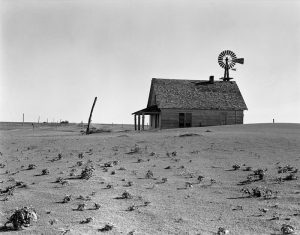
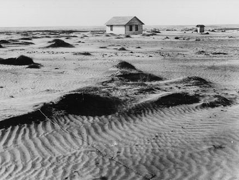 permanent agency of the USDA. The SCS was created in an attempt to provide guidance for land owners and land users to reduce soil erosion, improve forest and field land, and conserve and develop natural resources. It was the hope that the United States could prevent another Dust Bowl, and while small areas have a tendency to have dust storms, there has never been another era like the Dust Bowl era that the United States citizens suffered in the 1930s.
permanent agency of the USDA. The SCS was created in an attempt to provide guidance for land owners and land users to reduce soil erosion, improve forest and field land, and conserve and develop natural resources. It was the hope that the United States could prevent another Dust Bowl, and while small areas have a tendency to have dust storms, there has never been another era like the Dust Bowl era that the United States citizens suffered in the 1930s.
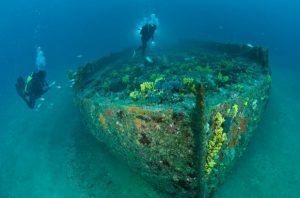 Over the years of shipping and wars on the high seas, the ocean floor has become riddled with ships. They rest on the ocean floors almost like ghosts of the past, but all that is changing. The old wooden boats have most likely rotted away long ago but the metal ships, and those that carried or contained metal, have remained…some, like the World War I ships, for over a hundred years. Nevertheless, time and man have taken their toll on those ships too. Corrosion, sea life, and salvagers have been slowly dismantling these relics, to the point that some are completely gone. It is the natural course, I suppose, but it does seem sad to think that those great battle ships will soon be gone forever. I’m not the only one who feels sadness over that prospect either. As the 100th anniversary of the beginning of World War I rolled around on July 28, 2014, members of the United Nations Educational, Scientific and Cultural Organization (UNESCO) met in Belgium to discuss ways of protecting the valuable underwater cultural heritage of the historic war. The organization plans to extend a 2001 convention in order to safeguard thousands more historic sites, including many World War I shipwrecks that are threatened by salvage operations, looting and other brands of destruction. The 2001 convention originally applied only to sites sunk more than 100 years prior to 2001.
Over the years of shipping and wars on the high seas, the ocean floor has become riddled with ships. They rest on the ocean floors almost like ghosts of the past, but all that is changing. The old wooden boats have most likely rotted away long ago but the metal ships, and those that carried or contained metal, have remained…some, like the World War I ships, for over a hundred years. Nevertheless, time and man have taken their toll on those ships too. Corrosion, sea life, and salvagers have been slowly dismantling these relics, to the point that some are completely gone. It is the natural course, I suppose, but it does seem sad to think that those great battle ships will soon be gone forever. I’m not the only one who feels sadness over that prospect either. As the 100th anniversary of the beginning of World War I rolled around on July 28, 2014, members of the United Nations Educational, Scientific and Cultural Organization (UNESCO) met in Belgium to discuss ways of protecting the valuable underwater cultural heritage of the historic war. The organization plans to extend a 2001 convention in order to safeguard thousands more historic sites, including many World War I shipwrecks that are threatened by salvage operations, looting and other brands of destruction. The 2001 convention originally applied only to sites sunk more than 100 years prior to 2001.
I suppose that to many people, especially salvagers, these under sea relics mean just one thing…money. But to historians…even amateur historians, like me, it is unthinkable to know that those pieces of history have come to nothing more than a way for looters, or salvagers, as they like to call themselves, to make money. It is much like robbing a grave if you ask me. These places truly are an underwater heritage, and while I’m not against recreational divers going in for a look, they should be required to leave it all as they found it…no  souvenirs. As an avid hiker, I have learned to respect the natural areas I visit, by not stealing from the sites, and not littering either. That way, the next person who visits gets to see the same beautiful sights that I got to see. It should be the same on the ocean floor, and while I don’t see myself visiting any of those historic places, I would like to know that if diving expeditions go there and post videos, it would not be of the leftovers, following a salvage theft.
souvenirs. As an avid hiker, I have learned to respect the natural areas I visit, by not stealing from the sites, and not littering either. That way, the next person who visits gets to see the same beautiful sights that I got to see. It should be the same on the ocean floor, and while I don’t see myself visiting any of those historic places, I would like to know that if diving expeditions go there and post videos, it would not be of the leftovers, following a salvage theft.
With technology getting better and better, the locations of many, if not most of the undersea relics are well known, and unfortunately that also leaves them vulnerable to looting. I suppose it will still happen, even with increased regulation against it, but maybe some people would be deterred. That is the goal anyway. According to UNESCO’s Ulrike Guerin, protection under the convention “prevents the pillaging, which is happening on a very large scale, it prevents the commercial exploitation, the scrap metal recovery, and it will have regulations on the incidental impacts, such as the problem of trawlers going over World War I sites.” After so many years underwater, these ships are already fragile. It’s up to us, the people of the world to step up now, and protect them to the best of our ability. We may not be able to protect them from the ravages of the salt water, the sea life, and the years, but we can do our best to protect then from the salvagers, thieves, and looters of the world, who might go to the sight for the sole purpose of their own profit…at the expense of the people of the world.
The UNESCO Convention on the Protection of Underwater Cultural Heritage, introduced in 2001 was designed to help member nations better protect shipwrecks, submerged ruins and other valuable, increasingly fragile, parts 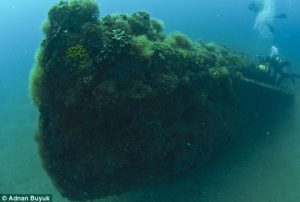 of their underwater heritage. The organization estimates that there are more than 3 million undiscovered shipwrecks scattered over the globe, including more than 12,500 sailing ships and war vessels lost at sea between 1824 and 1962 alone. With improved technology, these wrecks are becoming more accessible all the time, making them vulnerable to treasure hunters, commercial salvage operations and other types of looting…destroying these treasures for their own selfish, greedy gain. In my opinion, their preservation is more than just a good idea…it is our duty, and not only concerning World War I era wrecks, but also World War II era, and many other historic ship wrecks that could be photographed by legitimate expeditions for all to see.
of their underwater heritage. The organization estimates that there are more than 3 million undiscovered shipwrecks scattered over the globe, including more than 12,500 sailing ships and war vessels lost at sea between 1824 and 1962 alone. With improved technology, these wrecks are becoming more accessible all the time, making them vulnerable to treasure hunters, commercial salvage operations and other types of looting…destroying these treasures for their own selfish, greedy gain. In my opinion, their preservation is more than just a good idea…it is our duty, and not only concerning World War I era wrecks, but also World War II era, and many other historic ship wrecks that could be photographed by legitimate expeditions for all to see.
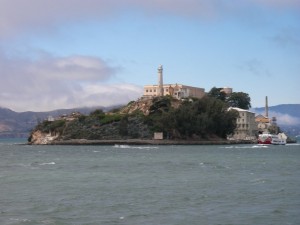 Sometimes, it has to be accepted that just maybe, something is impossible. Still, when a challenge seems impossible, there is always someone who comes along and proves that it can be done. Alcatraz island, and the prison that is located there were known to be impossible to escape from. Over the years that Alcatraz was open, there were 14 escape attempts. Myths and mysteries surrounded Alcatraz, and it’s seemingly inescapable water fortress for years. One of the many myths about Alcatraz is that it was impossible to survive a swim from the island to the mainland because of sharks. In fact, there are no “man-eating” sharks in San Francisco Bay, only small bottom-feeding sharks. The real obstacles the prisoners faced were the cold temperatures…which averaged 50 to 55 degrees Fahrenheit, the strong currents in the water, and the distance to shore, which was at least 1¼ miles. Those things combined were known to have bested most people who attempted to make it from Alcatraz to San Francisco.
Sometimes, it has to be accepted that just maybe, something is impossible. Still, when a challenge seems impossible, there is always someone who comes along and proves that it can be done. Alcatraz island, and the prison that is located there were known to be impossible to escape from. Over the years that Alcatraz was open, there were 14 escape attempts. Myths and mysteries surrounded Alcatraz, and it’s seemingly inescapable water fortress for years. One of the many myths about Alcatraz is that it was impossible to survive a swim from the island to the mainland because of sharks. In fact, there are no “man-eating” sharks in San Francisco Bay, only small bottom-feeding sharks. The real obstacles the prisoners faced were the cold temperatures…which averaged 50 to 55 degrees Fahrenheit, the strong currents in the water, and the distance to shore, which was at least 1¼ miles. Those things combined were known to have bested most people who attempted to make it from Alcatraz to San Francisco.
The prisoners tried every possible escape plan they could think of…from simply climbing over a fence to the most elaborate attempt which was made famous by the movie “Escape From Alcatraz,” when on June 11, 1962,  Frank Morris, and brothers John and Clarence Anglin cut through the walls, and made false walls to conceal their work, then placing “dummy heads” in their beds, so they would have all night to make their escape. Using raincoats turned into floatation devises, they made their escape. A cell house search turned up the drills, heads, wall segments, and other tools, while the water search found two life vests…one in the bay, the other outside the Golden Gate, oars, as well as letters and photographs belonging to the Anglins that had been carefully wrapped to be watertight. No sign of the men was found. Several weeks later a man’s body dressed in blue clothing similar to the prison uniform was found a short distance up the coast from San Francisco, but the body was too badly deteriorated to be identified. Speculation continues to this day as to whether or not the other two made it to safety.
Frank Morris, and brothers John and Clarence Anglin cut through the walls, and made false walls to conceal their work, then placing “dummy heads” in their beds, so they would have all night to make their escape. Using raincoats turned into floatation devises, they made their escape. A cell house search turned up the drills, heads, wall segments, and other tools, while the water search found two life vests…one in the bay, the other outside the Golden Gate, oars, as well as letters and photographs belonging to the Anglins that had been carefully wrapped to be watertight. No sign of the men was found. Several weeks later a man’s body dressed in blue clothing similar to the prison uniform was found a short distance up the coast from San Francisco, but the body was too badly deteriorated to be identified. Speculation continues to this day as to whether or not the other two made it to safety.
The official statement says they drown, and while it is likely that they did, it has been proven that it was indeed possible to swim from Alcatraz to San Francisco. Prior to the Federal institution opening in 1934, a teenage girl swam to the island to prove it was possible. Fitness guru Jack LaLanne swam to the island pulling a rowboat, 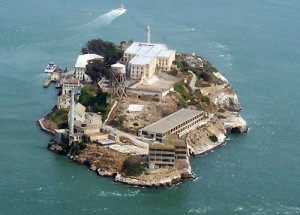 and several years ago two 10 year old children also made the swim. The official stand on that is that if a “person is well trained and conditioned, it is possible to survive the cold waters and fast currents. However, for prisoners, who had no control over their diet, no weightlifting or physical training (other than situps and pushups), and no knowledge of high and low tides, the odds for success were slim.” As to the escape attempts in which no body was ever found, we will never really know if they somehow managed to beat the odds and went on to live a quiet life under an assumed name or if they were swept away to be basically buried at sea. Either way, it is a very interesting subject to speculate on. I personally think that at least one of the three men made it.
and several years ago two 10 year old children also made the swim. The official stand on that is that if a “person is well trained and conditioned, it is possible to survive the cold waters and fast currents. However, for prisoners, who had no control over their diet, no weightlifting or physical training (other than situps and pushups), and no knowledge of high and low tides, the odds for success were slim.” As to the escape attempts in which no body was ever found, we will never really know if they somehow managed to beat the odds and went on to live a quiet life under an assumed name or if they were swept away to be basically buried at sea. Either way, it is a very interesting subject to speculate on. I personally think that at least one of the three men made it.

 When I first met my future sister-in-law, Jennifer Parmely, at the young age of 13 years, she was a vibrant girl, full of life, and she was what I thought of as a picky eater. Now, this didn’t upset me, but I just noticed that she would rather eat…well, what we would all today know is healthy, but still it seemed odd. What kid would rather eat chicken and salad than a cheeseburger? Actually, I can name a couple, because Jennifer wore off on my daughter, Amy Royce…so much so that I have wondered if she should have been Jennifer’s daughter, and not mine. Nevertheless, kids get traits from their aunts and uncles too, and that was the one Jennifer passed down to Amy. To my daughter Corrie Petersen, Jennifer passed down her laugh, and believe me when I say that they are identical!! I often wonder when Jennifer got there, when in fact it is Corrie.
When I first met my future sister-in-law, Jennifer Parmely, at the young age of 13 years, she was a vibrant girl, full of life, and she was what I thought of as a picky eater. Now, this didn’t upset me, but I just noticed that she would rather eat…well, what we would all today know is healthy, but still it seemed odd. What kid would rather eat chicken and salad than a cheeseburger? Actually, I can name a couple, because Jennifer wore off on my daughter, Amy Royce…so much so that I have wondered if she should have been Jennifer’s daughter, and not mine. Nevertheless, kids get traits from their aunts and uncles too, and that was the one Jennifer passed down to Amy. To my daughter Corrie Petersen, Jennifer passed down her laugh, and believe me when I say that they are identical!! I often wonder when Jennifer got there, when in fact it is Corrie.
Whether she knew it or not, Jennifer was well on her way to a life of health care, as well as a life of healthy living. She was a teeny little girl with a teeny little waist…that she still has, by the way, and yes she was a picky eater, but not is a bad way, as it turns out. It isn’t often that a young teenager has a pretty good grasp of ways to stay healthy, and I can’t say for sure that Jennifer had it all together, but at least in the diet arena, she did. As the years went on and Jennifer grew up, she had her babies, and like most women, gained a little bit of weight, but once she decided that it was time to get her life back together, she never looked back. Jennifer skies…both cross country and down hill. She snow shoes, hikes, and jogs. Her life is a flurry of activity, and it is what has kept her slender over the years.
Jennifer is also a full time nurse, in the Obstetrics department at Wyoming Medical Center, where she has worked since she was a candy striper beginning at 17 years old. So, in reality, she has been in the health care industry almost as long as I have known her, and most of our family has been blessed to have her in 
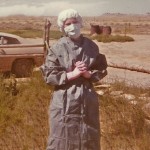 attendance at the births of the children and grandchildren. I would hate to have had my grandchildren come into this world with any other nurse, because we were so spoiled by the great care and advise we got from Jennifer. Nurses just don’t get better than she is. I’m sure her daughter-in-law, Ashley Parmely would agree too, since Jennifer has been there with her for the births of her daughters, and will be for the upcoming birth of her son, who will be Jennifer’s first grandson, too. Today is Jennifer’s birthday. Happy birthday Jennifer!! What a blessing you are. Have a great day!! We love you!!
attendance at the births of the children and grandchildren. I would hate to have had my grandchildren come into this world with any other nurse, because we were so spoiled by the great care and advise we got from Jennifer. Nurses just don’t get better than she is. I’m sure her daughter-in-law, Ashley Parmely would agree too, since Jennifer has been there with her for the births of her daughters, and will be for the upcoming birth of her son, who will be Jennifer’s first grandson, too. Today is Jennifer’s birthday. Happy birthday Jennifer!! What a blessing you are. Have a great day!! We love you!!

